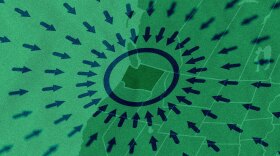A University of Washington physics professor with connection to the experiments at the CERN Large Hadron Collider said a Higgs-like particle has been discovered.
"We have discovered something ... and quite frankly I can't see how it can be anything other than the Higgs but we need scientific proof to close that door," said Gordon Watts, a physics professor at UW, at a tavern-based seminar tonight in lower Queen Anne with nearly 150 colleagues and science aficionados. "We just do not have the data yet to determine what the flavor of Higgs it is that we see.
"I am positive. My gut tells me that is what this is."
University of Washington scientists, colleagues and friends met for a pre-announcement 'seminar' near the Pacific Science Center in Seattle. At the event, several physicists explained the background of the Atlas detector at the Large Hadron Collider at CERN in Switzerland in the quest for the Higgs boson.
The UW played a significant role in the Atlas detector's development and work, the university said announcing the late night event.
"This is a huge milestone. We've never been able before to say that we have a new particle here," Watts said. "From the point of view of understanding how the universe works, this is huge."
http://www.youtube.com/watch?v=6enNgPrYlTA
Teams of scientists using the Large Hadron Collider at the European Organization for Nuclear Research, or CERN, announced in Geneva this morning that they have detected evidence of a new subatomic particle that bears the hallmarks of the elusive and highly sought after Higgs boson. In layman's terms, the Higgs is referred to as the "God Particle" because the field it produces gives atoms its mass. Were it not for the Higgs, the world we know would be completely different — there would be no chemistry, no architecture, no us. It would be a massless mess of aimless particles running around at light speed.
Higgs within reach
Our understanding of the universe is about to change…
The ATLAS and CMS experiments at CERN today presented their latest results in the search for the long-sought Higgs boson. Both experiments see strong indications for the presence of a new particle, which could be the Higgs boson, in the mass region around 126 gigaelectronvolts (GeV). The experiments found hints of the new particle by analysing trillions of proton-proton collisions from the Large Hadron Collider (LHC) in 2011 and 2012. The Standard Model of particle physics predicts that a Higgs boson would decay into different particles – which the LHC experiments then detect. A proton-proton collision event in the CMS experiment producing two high-energy photons (red towers). This is what we would expect to see from the decay of a Higgs boson but it is also consistent with background Standard Model physics processes. © CERN 2012
In 2008, the UW explained that, led by professors Henry Lubatti in physics and Colin Daly in mechanical engineering, UW professors helped design and fabricate nearly 90,000 tubes that are key to the workings of the Atlas detector. Atlas is one of six particle physics experiments that are part of the collider at CERN.
"It looks like we've caught the tail of a Higgs. Let's just make sure the rest of the animal looks like we thought it would," Watts said.
News of the discovery was apparently released accidently hours before the announcement by CERN. The Telegraph reports:
In the short film accidentally published by the lab yesterday spokesman Joe Incandela is seen describing how physicists at the Large Hadron Collider had "observed a new particle". It came as scientists gathered in Geneva ahead of the most heavily anticipated announcement yet on the hunt for the Higgs Boson, which takes place today. Among the audience will be Peter Higgs, the Edinburgh professor who first proposed the existence of the mysterious particle almost 50 years ago. Rumours have been rife that scientists hunting the Higgs will announce a new discovery, and the video appeared to confirm the finding of a particle matching its description.
The Higgs boson is a cornerstone of modern physics despite never being seen, the New York Times explains.
It is the last missing part of the Standard Model, a suite of equations that has held sway as the law of the cosmos for the last 35 years, and explains why things in the universe have mass. Physicists have been eager to finish the edifice, rule the Higgs either in or out and then use that information to form deeper theories that could explain, for example, why the universe is made of matter and not antimatter, or what constitutes the dark matter and dark energy that rule the larger universe.
The Higgs particle, and its associated field, were hypothesized back in the 1960s by British physicist Peter Higgs and others to fill a weird gap in the Standard Model, one of physics' most successful theories. The model as it stood had no mechanism to explain why some particles are massless (such as the photon, which is the quantum bit for light and other types of electromagnetic radiation), while other particles have varying degrees of mass (such as the W and Z bosons, which play a part in the weak nuclear force). By rights, all particles should be without mass and zipping around freely. The Higgs mechanism sets up a field that interacts with particles to endow them with mass, and the Higgs boson is the particle associated with that field
On the Web:









